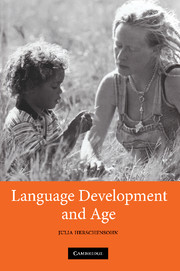Book contents
- Frontmatter
- Contents
- List of figures
- List of tables
- Preface
- Acknowledgments
- List of abbreviations
- 1 Just in time: is there a critical period for language acquisition?
- 2 Right on time: process and schedule of first language acquisition
- 3 All in good time: a window of opportunity for first language acquisition
- 4 Behind time: process and schedule of second language acquisition
- 5 Pressed for time: age constraints in second language acquisition
- 6 Biding time: further consideration of age and acquisition
- 7 It's about time: evaluation of age sensitivity in language acquisition
- Bibliography
- Index
5 - Pressed for time: age constraints in second language acquisition
Published online by Cambridge University Press: 22 September 2009
- Frontmatter
- Contents
- List of figures
- List of tables
- Preface
- Acknowledgments
- List of abbreviations
- 1 Just in time: is there a critical period for language acquisition?
- 2 Right on time: process and schedule of first language acquisition
- 3 All in good time: a window of opportunity for first language acquisition
- 4 Behind time: process and schedule of second language acquisition
- 5 Pressed for time: age constraints in second language acquisition
- 6 Biding time: further consideration of age and acquisition
- 7 It's about time: evaluation of age sensitivity in language acquisition
- Bibliography
- Index
Summary
Introduction
Early in the novel Native Speaker, Chang-rae Lee's hero Henry Park meets his future wife (a speech therapist, naturally):
“People like me are always thinking about still having an accent,” I said …
“I can tell,” she said.
I asked her how.
“You speak perfectly, of course. I mean if we were talking on the phone I wouldn't think twice.”
“You mean it's my face.”
“No, it's not that,” she answered … “Your face is part of the equation, but not in the way you're thinking. You look like someone listening to himself. You pay attention to what you're doing. If I had to guess, you're not a native speaker. Say something.”
(ibid., 12)Henry's perfect pronunciation on the phone seems to confirm the widespread belief that younger learners are more adept than older ones at language acquisition, but his self-consciousness belies the dilemma of immigrants whose nonnative origins surface in subtle ways, both linguistic and social.
Chapter 3 presents evidence that there are biological factors that limit the ability of children to acquire L1 completely under deprived circumstances (with deprivation either of environmental input or of the organismic cognitive system). Normal L1A – most of which takes place in the first four years of life – is quite uniform in schedule and process cross-linguistically. It may be delayed up to age five, but subsequently shows progressive deterioration through childhood.
- Type
- Chapter
- Information
- Language Development and Age , pp. 134 - 171Publisher: Cambridge University PressPrint publication year: 2007



